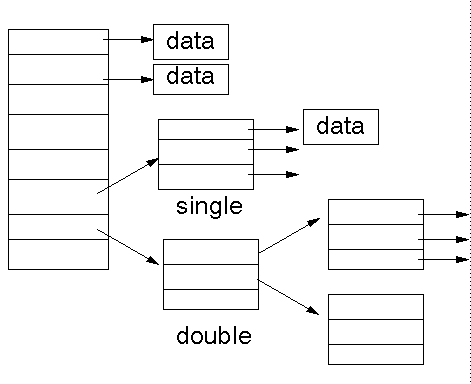
Many old systems that used to read 80 column cards use an 80 character record structure (eg the Burroughs A9)
Some mainframe systems use a tree organisation for files, where each node is indexed by a key.
Directory files are used by the O/S to maintain the hierarchical file system.
Character special files are devices at a fixed location, with volatile contents. Reads from such files are actually reads from the device. No random access is available on such files. Examples are keyboard, mouse etc. In Unix, these are /dev/kbd, /dev/mouse, /dev/audio, etc
Block special files are also devices, but which allow random access. Examples are SCSI disks /dev/sd0, etc, memory /dev/kmem and floppy disks /dev/fd0

Then you can store the start of the file somewhere else. This makes it easier to find where a file is, because the index table can be stored in fast memory instead of on disk, and actual data can be full blocks.
MSDOS uses this system. The root directory is at a fixed location on the disk, and is contiguous of fixed size. (This is why you cannot have an unlimited number of files in the root directory in MSDOS.) Entries in this for the start of each file in the root directory point to the FAT (File Allocation Table) which is the index table for the rest of the disk.
When a new file is created or extended, new blocks can be found by looking through the FAT for unused entries.

The advantages are that there is quick access to the first blocks, and potentially huge file sizes. This method is used by Unix.
The inode is used to store all information about a file, and there is one inode per file. This information includes: owner, time last modified, time last accessed, size, file permisssions, number of links, etc.
For example, Minix is a simple version of Unix, and Linux has the option to use a Minix file system. A Minix inode is defined by
struct minix_inode {
unsigned short i_mode;
unsigned short i_uid;
unsigned long i_size;
unsigned long i_time;
unsigned char i_gid;
unsigned char i_nlinks;
unsigned short i_zone[9];
};
This has 7 direct blocks and 2 levels of indirect block.
When a new file is created (by creat), it creates a new inode entry in the inode table.
One method of keeping the free list is as a linked list. Traversal of this may be slow, and it takes up space. Another method (used for small computers) is a bit vector. In this, the first block is represented by bit 1, the second by bit 2, etc. A block is free if its corresponding bit is zero, not free otherwise. Special hardware instructions may support quick perusal of this vector.
The simplest way of allocating a block from this list is FCFS (first come first served), but other algorithms are possible. For example, since directories are accessed very frequently, placing blocks for them close to the middle of the disk may speed up access to them.
It is becoming increasingly common to reduce the amount of disk access required by caching. In this a copy of something is kept in fast memory rather than on disk. For example, a block may be read into memory. If another read is required from the block, then instead of re-reading it from disk, the read is taken from a copy of the block in RAM.
The high level I/O functions are often implemented using a cache or buffer. When a read is first requested, say by getchar, a block is read into an input cache for that file, Successive getchar's are from this buffer until it becomes empty, at which point another block-read is done. This block read is tuned to the disk.
Caching may be of read-only data, such as compiled program code. The cache size should be big enough that a substantial amount of execution is done using just the code in the cache.
When data is changed, caching becomes more interesting. Suppose I am modifying
a file, and I make a change. To reduce disk I/O this should be cached locally,
and not written until a lot can be written. Suppose the system crashes or someone-else
wants to make use of the file in the meantime. The caches and disk will be
inconsistent. The simplest solution is a write through cache, so that writes
are reflected immediately on the disk. Of course, this loses some of the potential
savings...
 Program Development using Unix Home
Program Development using Unix Home